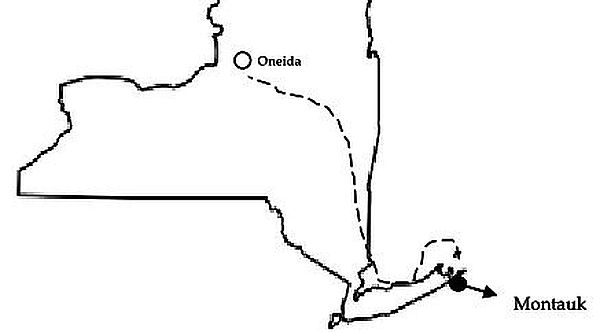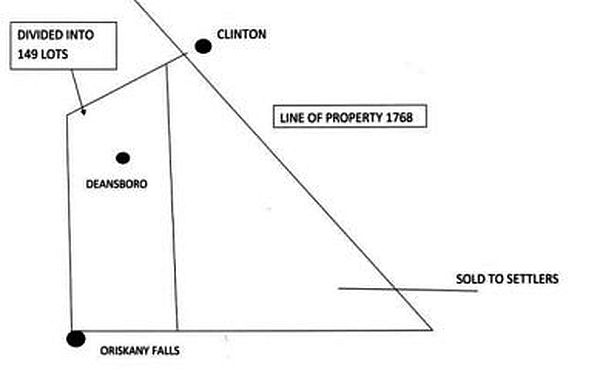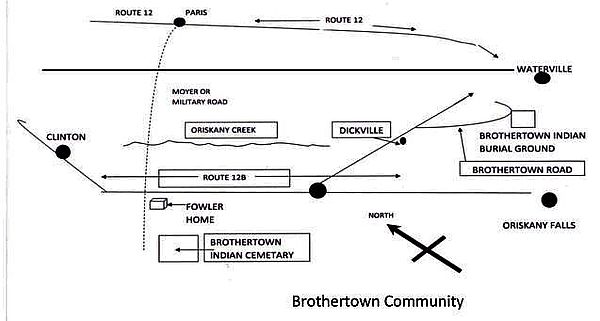The Brothertown Indians were among the first settlers in what is now the Town of Marshall and the southern parts of the Town of Kirkland. The Brothertown Indian Nation was and is a culturally distinct, politically independent tribe; it began as a unique communal vision. Today, there are about 5,000 Brothertown Indians scattered across the country. Their founders have significantly contributed to many areas; they have in large part vastly improved their lives, education and standard of living as well as the lives of those around them. Any one of those Brotherton can trace their ancestry back to the Algonquain-speaking Native Americans, who roamed the eastern part of the country millennia ago. The tribes whom the Brotherton call their "parent tribes" were the Narragansett, the Mohegans, the Montauks, the Tunxsis, the Niantics and two Pequot tribes. Some smaller tribes were most likely included.
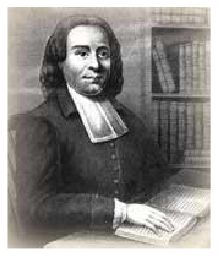 Samson Occom, a Mohegan Indian and a Presbyterian minister, ordained in 1758, was an itinerant minister to the New England tribes, and was deeply distressed by his fellow Indians' plight — the European settlers tried to drive the Indians from their homes - and sought a solution to their problems.
Samson Occom, a Mohegan Indian and a Presbyterian minister, ordained in 1758, was an itinerant minister to the New England tribes, and was deeply distressed by his fellow Indians' plight — the European settlers tried to drive the Indians from their homes - and sought a solution to their problems.
In 1761, Occom and his brother-in-law David Fowler traveled to upstate New York State and taught among the Oneida Indians (of the Iroquois confederacy) for about a year, at the Oneida's request for an educator. They represented to the Oneida Indians, who were land-rich at the time, that unless the New England Christian Indians emigrated from the east, all those tribes would become extinct. The Oneidas agreed to give to the New England Indians a large tract of land with the right to use it as they wished. Occom and Fowler went back east to spread the good news and to further encourage the reluctant Native Americans to move west. In July, 1774, Occom traveled again to the Oneida territory with David Fowler to further articulate the understanding they had reached concerning the Eastern Christian Indians migration to the west. He met again Samuel Kirkland, missionary to the Oneidas, and according to his journal they "embraced each other with joy."
In October, 1774, they were joined by Mohegan Joseph Johnson, now Occom's son-in-law, and Sir William Johnson, Superintendent of Indian Affairs, and his nephew Guy Johnson, to serve as negotiators. The Oneida Indians signed over to the New England Christian Indians, as they were known, a tract of land of about 12 square miles which stretched approximately from Madison Lake to College Hill, Clinton west of the Line of Property of 1768 "without power of alienation." That meant they could hunt and conduct their own affairs in Oneida territory, but could neither sell nor lease the land to other Indians nor to white settlers. In the Iroquois tradition, the Christian Indians became politically subordinate to the Oneidas, while retaining the right to manage their own internal affairs; in their negotiations, the Oneida Indians "adopted" the Christian Indians, in effect becoming their elder brothers.
The first contingent to New York was in 1775, led by Joseph Johnson and David Fowler, with 50-75 settlers. Occom followed a few years later, after attempting to earn extra money by preaching along the route. They set about clearing land, planting crops, building houses. However, that turned out to be a poor time in which to settle, as the Revolutionary War broke out in earnest in New York State, causing the tribes to scatter, due to conflicting allegiances, interrupting further immigration. Some went back to their New England homes; others were protected at Fort Stanwix in Rome; some fled to the Stockbridge Indians in Massashutsetts. Samson Occom counseled neutrality, because he didn't want his people in the middle of a white man's war, which put the Brotherton at odds with the Oneidas, who supported the patriots. However, soon after the war began, the Brothertown Indians fought on the side of the patriots and suffered heavy losses in consequence, for example Joseph Johnson, who was part of the group which negotiated with the Oneidas, disappeared while he was on a mission of peace for General Washington. That was a huge blow to the community.
In 1783 the Treaty of Paris was signed, the war was over, and little by little the New England Christian Indians returned to their village with members of the Stockbridge Indians, who had suffered in much the same way, to find that the potatoes they had planted had multiplied. What we have termed, variously, the New England Christian Indians felt it was time to formally organize into their new community, so in 1785 they named themselves Brothertown or Ee-yaw-quittoo-wau-connuck, because they intended to live in brotherhood and harmony the rest of their lives. They adopted a government much like that of the New England setters, particularly Connecticut, which they felt would give them more autonomy and independence. They elected officers, such as peacemakers, fence-viewers, overseer of the poor, two marshals. There were very strict rules regarding profanity, intoxication, adultery, neglect of children, theft, and idleness. Samson Occom was their spiritual leader and the glue that held them together. They also came back to find that their relationship with the Oneida had cooled. The Oneidas felt that the Brothertown Indians had not honored their contract: during the war, the tribe had become intermixed with other tribes and races, despite Occom's best efforts to keep that from happening, violating, the Oneidas believed, their contract. They also believed that the Brothertown had turned their backs on their heritage. But most grievous of all, they had failed to honor and support their elder brothers. Even though the Brotherton did not remain neutral during the Rev. War, the Oneidas held their initial neutrality against them. The Oneidas pointed out that kinship worked both ways and believed that the Brothertown Indians had violated a fundamental trust, that of a younger brother honoring and supporting the elder brother, especially in time of war.
Whatever the reason, the Oneidas wanted their land back. Occom and Fowler dug in their heels: no, the land transfer had been above board, witnessed by the Superintendent of Indian Affairs. Then the Oneida said, well, we'll reduce your land to 640 or one square mile. No, they wanted the original 12 square acres, as agreed upon. The Oneidas gave them several more options (live at large on their land; different sizes of land), until Samson Occom, tired of being pestered by the Oneidas, who wanted them out, applied to the secretary of state to help them out. The Treaty of Fort Schuyler of 1788 granted the Brothertown Indians 2 miles in breadth and 3 miles in length. The Stockbridge Indians were granted six square miles. In 1789 the state intervened again to acquire a large parcel of land from the Oneidas in exchange for money, and then gave the land to the Brothertown Indians with the added benefit that they would be able to lease the land for up to 10 years to the land-hungry whites, who were supposed to stay out of Indian land per the Line of Property established in 1768 to keep whites out. Samson Occom counseled against leasing: what if they never got their land back? He saw it as a slippery slope toward the Indians losing their land once again.
When Occom, their leader, died in 1792, the Brothertown fell apart as a community. They became prey to religious factions, took heavily to drink, and leased their land so randomly, now that Occom was not there to warn against it, that they were in danger of losing it altogether. All this came to the attention of Governor George Clinton, who admired Occom. In 1795, about 60% of the land was sold to the whites at about 16 shillings an acre, and the money put into trust for the future of the Brothertown Indians. 40% of the land was divided into 149 lots for the Brothertown Indians. Through this effort, the Brothertown kept their land, but this divested the tribe of more of its independence. Even so, the lobbying efforts of the leaders, coupled with the benevolence of the state authorities ensured the survival of the Brotherton, and Samson Occom's efforts, wisdom, and courage were rewarded.
Still, Gov. Clinton felt that, with the absence of Samsom Occom, the Brothertons needed someone to oversee them and protect their interests. He arranged for John Dean, a Quaker, to take over guardianship of the Indians. The Brotherton were wary of this appointment. They saw it as yet another threat against their autonomy, and were afraid that John Dean would co-opt their religion. They needn't have worried: the advent of the Deans was a very good thing.
John Dean came in 1795, and three years later, brought his wife and 19-year-old son Thomas to the area. They lived right in the center in what is now downtown Deansboro, on Route 12B. They knew how to guide the Indians without offending their autonomy. They played an important role in the stability and sustainability of the community. Indeed, the Deans won their affection and confidence. Deansville, as it was called then, was named for Thomas Dean.
For several years, the Brothertown community went along smoothly. They had sawmills, grist mills, tanneries. The lands were cleared and planted, and the houses well-built and numerous At its height, Brothertown boasted at least 200 people, and thousands of acres were cleared and cultivated. But the whites kept pressuring the Brotherton to let them lease their farms, and kept trespassing onto their territory. Thomas, who had taken over from his father by that time, could see that the Indians were not treated fairly by the whites.
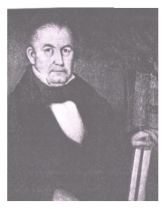 Thomas Dean pleaded for land for the Brothertown. He first traveled with some tribe members to Indiana, and then he was offered land in Wisconsin. He traveled with them down the Erie Canal to Buffalo, to the Great Lakes and Green Bay, Wisconsin, on a large tract of land (over 26,000 acres) on the Fox River. They had hardly settled in, however, when the government negotiated land on Lake Winnebago, where they moved next. Between 1824 and 1848 most of the Brothertown Indians in New York had moved to Wisconsin. By all accounts, early years in Wisconsin were good for the Brothertown Indians. They excelled in many trades, and made significant progress in agriculture. While in Wisconsin, the Brothertown Indians petitioned the government for citizenship in an effort to not have to move and to keep their land, and that was granted in 1839.
Thomas Dean pleaded for land for the Brothertown. He first traveled with some tribe members to Indiana, and then he was offered land in Wisconsin. He traveled with them down the Erie Canal to Buffalo, to the Great Lakes and Green Bay, Wisconsin, on a large tract of land (over 26,000 acres) on the Fox River. They had hardly settled in, however, when the government negotiated land on Lake Winnebago, where they moved next. Between 1824 and 1848 most of the Brothertown Indians in New York had moved to Wisconsin. By all accounts, early years in Wisconsin were good for the Brothertown Indians. They excelled in many trades, and made significant progress in agriculture. While in Wisconsin, the Brothertown Indians petitioned the government for citizenship in an effort to not have to move and to keep their land, and that was granted in 1839.
